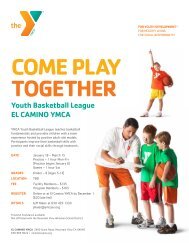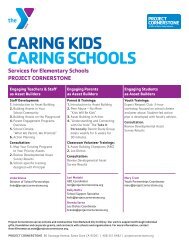Camp Campbell Outdoor Science School Teacher & Parent ...
Camp Campbell Outdoor Science School Teacher & Parent ...
Camp Campbell Outdoor Science School Teacher & Parent ...
Create successful ePaper yourself
Turn your PDF publications into a flip-book with our unique Google optimized e-Paper software.
the past and it will look different in the future. Good questions: Is all erosion caused by humans? Whatelse could cause erosion? How does erosion impact the water quality and what lives in the water?*Be sure to use your CL’s wisely for this activity, have them spread out and be in charge of differentactivities (e.g. kick netting, setting up the sorting station, pH strips and YSI meter)Once you have a sample (or multiple, depending on the richness of the samples) gather all the studentsaround for sorting (you can have them work individually or in teams). Once the sample is sorted askthem to pull out the field journals and flip to aquatic invertebrate dichotomous key page. Teaching points: Each step is a question and depending on your answer you are sent to a new question. I often tellstudents it’s like a chose your own adventure book, you have an option and if you don’t think youwere right you can always back track or completely re-start. Walk them though a couple of examplesGive them time to explore, handle and ID the invertsRemind everyone that these are living insects and we should treat them with respec t while we IDthem. Once we are done we will release them back into the river.Introduce the pollution tolerance index Talk about indicator species Talk about what you found that day and what they means in terms of water quality Compare past dataIntroduce how the different aquatic inverts are specially adapted to living and surviving in theirenvironment. Spend some time talking about each invert you find and how they: hunt, hide andreproduce. You can follow this discussion up with a “build-a-bug” activity or sketching session after thewhole lesson is over.Wrap-up and Assessment:Ask the students to write down the different ways they think that oxygen gets into the water (havethem write it on the same page that they originally wrote their ideas on, have them compare andcontrast). You can also have them list these on a white board so it is a collection of everyone’sthoughts.Ask the students to write down different ways pollutants get into the water (have them write it onthe same page that they originally wrote their ideas on, have them compare and contrast). You canalso have them list these on a white board so it is a collection of everyone’s thoughts.Ask them to name at least two new scientific tools that they got to use for the first t ime today.Ask them why they thought we did this specific lesson and why it’s important to know about thehealth of the riparian ecosystem. Spend some time working through this question with thestudents.Survey the students (raise their hands) in regards to how many of them are comfortable andconfident using a dichotomous key.Compare your data to past data collected by previous groups. This can open you up to having alarger discussion about the “big picture” and how the riparian environment changes over time.Teaching points: Are the changes natural? Are the changes caused by human interaction with theenvironment? Has the river becomes more or less polluted, or is it the same?20





